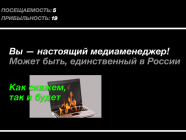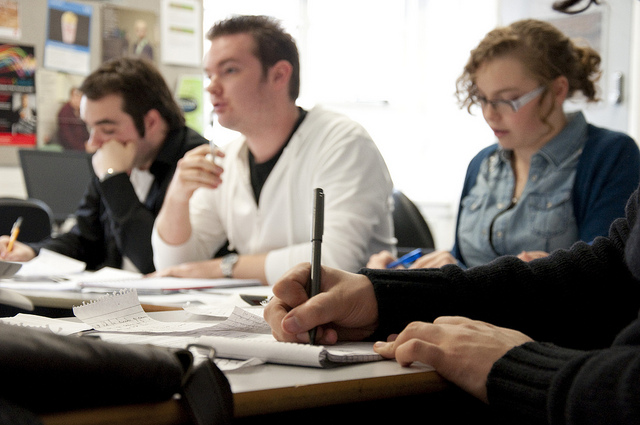 There’s a selection of people in the media industry who’ll say that professionals fall from heaven.
There’s a selection of people in the media industry who’ll say that professionals fall from heaven.
Some claim only natural talent, not journalistic education, is needed for a news career. Media research is similarly considered superfluous, as whatever skills one needs can acquired in the newsroom. And the newsroom itself has been regarded for long time as an immovable construction – surely not a place which can be molded. Naturally, it is difficult to introduce quality management in such an environment, however it remains urgently needed.
The path towards improvement in journalism is long, narrow and – at this point – sloping. The book Medienqualität durchsetzen (Implementing Media Quality) is a milestone along this trail, with its authors determined to achieve better journalistic quality by way of intelligent, innovative newsroom management. At the same time, they are realistic and pragmatic: Quality needs to be implemented – against resistance caused by unfriendly circumstances and economic conditions, bucking the bums and naysayers inside newsrooms.
In gastronomy fresh, aromatic condiments make it possible to create salubrious dishes. However, the cook must know his craft as well. To stay with the metaphor: The condiments in this handbook are perfect. Recent examples, check lists, summaries and illustrations – most closely related to Swiss newsroom realities – make this a useful, indispensable resource for newsrooms.
The three “cooks” behind this particular book compliment one another in a congenial fashion. Media researcher Vinzenz Wyss is a pioneer of journalistic quality research in the academic world. Peter Studer is a former newspaper and TV editor-in-chief with a strong background in law, and as the president of the Swiss Press Council he dealt with professional ethics and issues of journalistic quality for many years. Toni Zwyssig was a journalism educator and directed the SRG/SSR training program, one of the most ambitious offers of journalistic education in the German-speaking world. Together, the authors relate to longstanding traditions of quality research in journalism as well as to change management research. The rich union of scientific, journalistic and pedagogical competence has produced a highly rewarding, readable book.
The subtitle, Qualitätssicherung, is a reference to securing quality. This may sound somewhat defensive at a first glance, but attaining a higher level of journalistic quality than what already exists in Switzerland may be a lofty expectation for the future. If we are complaining, we complain on a high level. Many of the old mainstream media and their newsrooms lack resources, due to various new possibilities to advertise in social networks and search engines. Thus, during the years to come we may have to focus more on securing than on enhancing journalistic quality.
In particular, to achieve this more modest goal the handbook provides a number of suggestions worth testing out. Many may even contribute to maintaining quality standards without costing very much. For example, setting goals precisely, conducting continuous and frequent self-critical discussions of quality issues in newsroom meetings, creating correction corners and policies and utilizing new online options for quality management need not be expensive. However, leadership and a willingness to learn and to encourage colleagues to learn as well are required.
The architecture of the book consists of six building blocks. The first deals with rules like legal norms and ethics codes – the framework of guidelines for journalistic work under conditions of press freedom. The second cornerstone refers to “management by objectives,” and aims to convince media practitioners that even in a newsroom environment with all the uncertainties of “routinizing the unexpected,” setting clear goals is essential if quality management is supposed to work. The third segment discusses resources and process management in newsrooms, and how they’ve been altered in dealing with convergence and introducing new multimedia desks. A separate module presents a culture of constructive self-criticism, explaining how such a culture can be developed in newsrooms by creating continuous feedback loops and a discussion. The fifth cornerstone deals with personal development and training, and the last one examines how journalism’s credibility and the relationships between newsrooms and the public can be improved with the help of ombudsmen, corrections management and an intelligent use of social media.
The strength of the book lies in its description of how such learning experiences can be induced in an interactive, multi-step process. Some editors may be discouraged as the manual is strongly influenced by experience gained in Swiss public broadcasting, which could prove difficult to transfer to the newsroom realities of the private sector. This, however, is no excuse for neglecting to engage in newsroom quality management.
In the long run, journalistic quality will only be achieved where the public demands such quality. Only when recipients are willing to pay for quality will media managers and journalists reflect seriously about quality management. This is where the cat bites his own tail, as it also works to the contrary: Only when media managers and journalists begin to intensely inform the public about media and journalism will there be audiences who are well informed about media and will therefore demand higher levels of journalistic quality.
Vinzenz Wyss/Peter Studer/Toni Zwyssig: Medienqualität durchsetzen. Qualitätssicherung in Redaktionen. Ein Leitfaden, Zürich: Orell Füssli Verlag, 2012
Tags: Management by Objectives, Media Journalism, Media Management, Newsroom Implementation, Peter Studer, Quality Media, Toni Zwyssig, Vinzenz Wyss













































